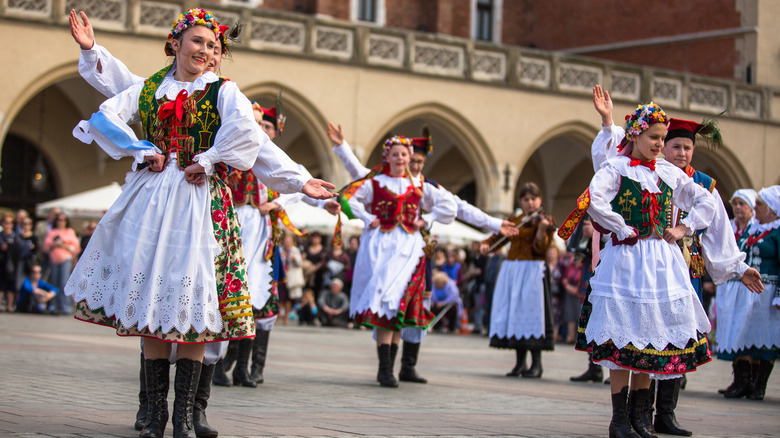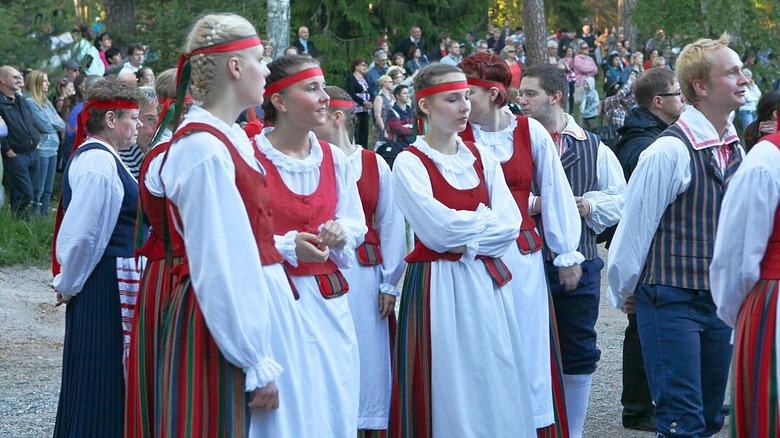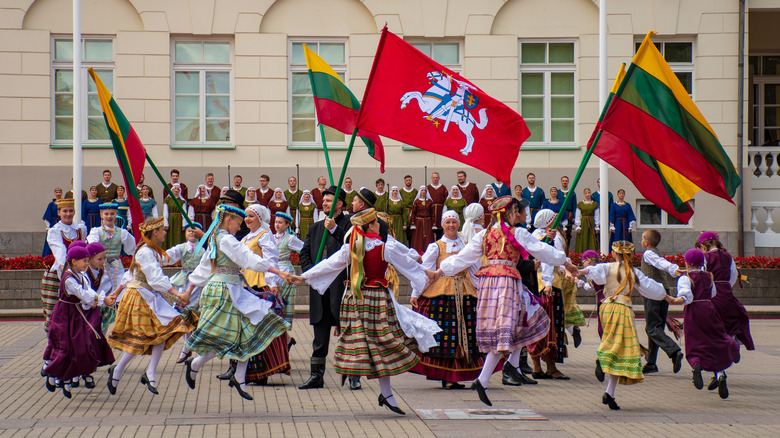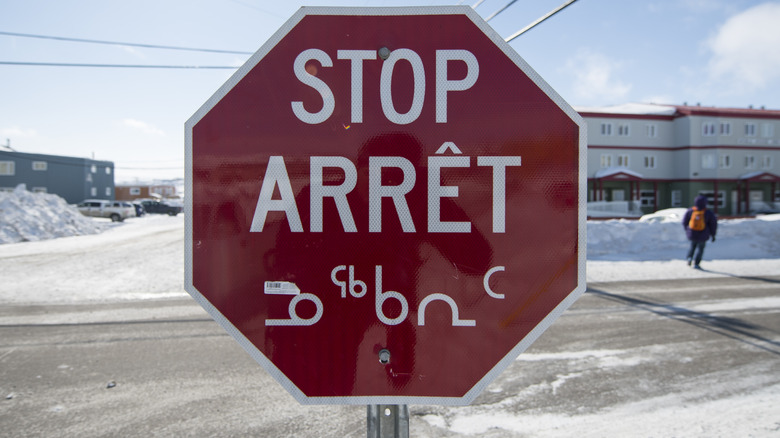These Are The Hardest Languages For English Speakers To Learn
Language learners frequently ask "which language is the most difficult?" Searching that question on Google will reveal millions of hits linking to lists that are ultimately subjective, since language difficulty is in itself depends on a person's linguistic background. Furthermore, most lists borrow heavily from the CIA language difficulty grading, which only includes major world languages of interest to the agency's aims.
The CIA category III and IV languages are hard, no doubt about it. But there are plenty of resources and native speakers for learners to practice with. Numerous smaller, endangered languages exist that are mind-bendingly complicated, without the same recognition or resources available for learners. Any list should include a diverse mix of better-known languages and some of the lesser-known hard ones. In that vein, here are some of the most difficult languages for English speakers to learn from across the globe that make the CIA list look like child's play.
Chinese
The Chinese language is thought of as a behemoth. Yet, according to the University of Warwick, it is actually one of the easiest to learn – at least in terms of grammar. It does not have any conjugated verbs, tenses, irregular verbs, gender or number distinctions for nouns and adjectives, articles, plurals, or unfamiliar word order. In fact, word order — subject-verb-object — is exactly the same as in English. So where does the language's legendary reputation for difficulty originate?
Not accounting for the script, which although difficult, is not necessary to learn how to speak, Chinese poses a challenge because it is a tonal language. Chinese words are incredibly simple, monosyllabic words that can be combined to form more complicated words. But to compensate for phonological simplicity, tones are used to differentiate meaning. Thus, according to ThoughtCo, a difference in pitch determines whether the word "ma" means "horse," "mother," "hemp," or "to scold."
While students can differentiate tones in a classroom setting, correctly using them in everyday conversation is more difficult. Using the example of Sri Lankan students, researchers noted in the journal IJRIAR that Sinhala-speaking students of Chinese imposed their language's own tonal inflections on Chinese, which, naturally, could cause problems with mispronounced words. Thus, mastering the language requires daily conversation and engagement with native speakers to get a grip of the nuances of Chinese phonology. On the other hand, the learner that can master the tones has a relatively easy path to mastery, since the nuts and bolts of the language are very simple.
Polish
The CIA classifies Slavic tongues as category III languages, which include English's more distant Indo-European relations. Slavic languages challenge English speakers with their grammar, and in some instances, the Cyrillic alphabet. Among the most difficult for English speakers is Polish, whose concept of virility combined with an intimidating pronunciation stumps learners.
Polish consonants and consonant clusters drive learners crazy. The most famous Polish tongue twister, according to Kultura, which is also used to intimidate learners for fun, reads as follows: "W Szczebrzeszynie chrząszcz brzmi w trzcinie." As you can see, Polish has no problem sticking tons of consonants together. Coupled with the clusters are the consonants dź, ź, ś, and ć, which are not present in other Slavic languages. According to the University of Illinois, these are separate from sz, cz, and ż, which are pronounced similarly to "ch" and "sh" in English. Instead, the former group is pronounced with the tongue high and the mouth constricted to produce a "softer" sound that English speakers cannot easily differentiate.
Polish grammar generally resembles other Slavic languages, but includes the concept of virility. According to the University of Michigan, Polish differentiates between grammatically masculine nouns (e.g. "dog") and biologically masculine nouns (e.g. "man"), which take separate sets of endings for the basic plural. So "pies" (dog) becomes "psy," but "mąż" (man) becomes "męzi." Because virility has a complicated set of rules that often results in letter changes, Polish learners tend to study the basic plural last.
Finnish
Finnish is another CIA category III language, along with its relatives Estonian and Hungarian. This very logical, straightforward language has no gender or articles, and few exceptions to its rules. So why the challenge? Finnish is an Uralic language related to the languages of Siberia, Northern Russia, and Northern Scandinavia. Thus, one cannot hope for similarities to English when learning vocabulary or grammar, which is very different from relatively simple English grammar.
According to the linguistics handbook Morphologie, Finnish has 15 grammatical cases expressed as endings to describe the roles of nouns, adjectives, and pronouns in a sentence . So the word "talo" (house) becomes "talon" (of the house) or talossa (in the house). Fortunately, though, there is only one set of endings that apply to all words. According to Stanford, the real difficulty in Finnish nouns is consonant gradation. This phenomenon describes seemingly arbitrary changes in certain endings of words whose stems end in k, p, or t. So "halko" (log) becomes "halon" (of the log) instead of the expected "halkon" while "suku" (relative) becomes "suvun" (of the relative).
To top it all off, This is Finland notes that once a learner has put all the effort into learning standard Finnish, he must learn spoken Finnish, which diverges from the written language. So while Finnish grammar may make sense in a classroom setting, using it in everyday conversation that bends many of the hard-and-fast rules makes Finnish a unique sort of challenge. At least it uses the Latin alphabet.
Lithuanian
This CIA category III language together with its close relative Latvian make up the Baltic group of the Indo-European (IE) language family. Lithuanian, according to the Lithuanian Quarterly Journal of Arts and Sciences, holds a special place in the IE family as the most archaic, having preserved a variety of endings, vocabulary, and forms that English has discarded. As a result, it bears a strong similarity to older IE languages such as Latin and Sanskrit, but it is arguably more complicated than both.
Lithuanian's difficulty begins with a complicated case system full of exceptions and free word stress (stress can occur on any syllable). Meanwhile, Lithuanian vocabulary, according to Professor Olegas Poliakovas (via Delfi) of Vilnius University, have changed relatively little compared to Proto-Indo-European, the hypothetical ancestor language of all IE languages. So while the Lithuanian word "avis" means sheep, one must know the obscure English "ovine" to see the connection, since the English word has a different origin.
The Lithuanian Quarterly Journal of Arts and Sciences notes that participles are another stumbling block. Lithuanian has a grand total of 13 that can each take one of 24 forms depending on their roles in a sentence. English, for comparison, only has two – a present and a past participle ("doing" and "done," for example). But in a way, this simplifies things. Lithuanian can express the English "the one who had worked" with just one word — "dirbęs."
Arabic
The Arabic language draws its prestige as Islam's liturgical language and as the lingua franca of much of the Middle East. For non-natives, it is quite a challenge. According to the University of Warwick, Arabic, like any good Semitic language, logically assembles words from three letter consonant roots that are filled in with vowels. As seen in the Quranic corpus, the root k-t-b (related to writing), gives forms such as "kitab" (book) "katab" (to write), "maktab" (school/office), and numerous verb forms. So while vocabulary is easy to derive and recognize, the sheer number of forms can be intimidating.
Arabic verbs can seem immensely complicated. Whereas English has different verbs and wordy constructions for things such as passive voice or reciprocal actions, Arabic expresses these with individual verbs derived from its root system. There are 10 types of verbs as illustrated by Dr. Abdallah Alshdaifat's thesis "The Formation of Nominal Derivatives in the Arabic Language." The verb forms' meanings depend on the infixes and prefixes attached to the three-letter root. So for example, changing the verb "katab" (to write) to its reciprocal form "takātaba" changes the meaning to "to correspond." Usually, the meanings usually relate back to the original root, making Arabic quite logical in this respect. It can just be a handful for the uninitiated. Fortunately, YouTuber and native Arabic speaker Loubna Duymayan also breaks it down for laypeople.
Navajo
Journalist Marc Simmons of the Santa Fe New Mexican recalled one of his summer jobs working at a Navajo mission. After arriving, he told the pastor that he was interested in learning Navajo. The pastor and his family laughed at him. Simmons explains this by citing travel writer J.H. Beadle: "I set out most industriously to learn the language," he wrote, "but at the end of a day's hard work, I'd only mastered two words."
Navajo's difficulty begins with the phonology, which Beadle claimed that "No alphabet of civilized man can represent." From Swarthmore University's phonology guide, it is clear where this conclusion came from. Navajo has four tones, frequent glottal stops (the sound between "uh" and "oh" in "uh-oh"), and many sounds without English equivalents. Consonant pairs such as b and p or t and d sound the same to an untrained ear, but can distinguish different words. According to the University of Arizona journal Coyote Papers, Navajo verbs pose the biggest challenge. They distinguish between actions that are in the moment, ongoing, repeated once, or repeated many times. There is even a separate form called the "semelfactive," which refers to one particular iteration of a repeated action. Thus, it is said that if Navajo is not learned as a child, it is almost impossible to achieve working fluency, especially for speakers of the distant and unrelated Indo-European languages such as English. For its difficulty, the National WWII Museum notes that the famous Navajo Code Talkers used the language during World War II to deliver classified messages.
Circassian
Linguist Louis Loewe tells that an Ottoman scholar once traveled to the Caucasus to record the local languages, where met the Circassian people. Upon returning, the sultan asked what their language sounded like. The scholar rattled a bag of pebbles. That was the best he could do. Loewe agreed with this statement, calling Circassian "one of the most difficult in the world."
This apocryphal story refers to the relatively large number of sounds found in the Caucasian languages. According to Phoneme and Morpheme in Eastern Adyghe, Circassian is no outlier, with a total of 52 sounds. Of these, a whopping 49 are consonants — twice as many as English's 24 — with only three vowels. Most do not exist in English and are difficult for non-natives to reproduce. Circassian isn't even the worst in this regard, as its relatives in Abkhazia, according to the World Abaza Congress, have over 60.
Circassian grammar is also unfamiliar to English speakers. According to "A Grammar of Kabardian," the language has a different type of grammatical alignment called ergativity. Take the English sentence "the girl knows it." "The girl" is the subject, and "it" is the direct object. But in ergative alignment, the sentence subject is "it," while "the girl" is the agent. Thus, the Circassian equivalent "pśāśa-m mə-r ya-ś'a" would best be rendered in the English passive voice, which confuses English speakers used to active constructions. Fortunately it only applies in sentences with a transitive verb.
ǃXóõ
While the languages of the North Caucasus have intimidating phonologies, there are even more complicated languages out there. You could be forgiven for wondering what ǃXóõ meant. After all, exclamation marks are sentence markers in English, not letters. But this unfamiliar-looking word is the indigenous name of the Taa language, one of several Khoisan languages of southern Africa's Kalahari Desert.
The ǃXóõ language is a true gem. According to the New York Times, it is a click language, with over 200 sounds by some counts. The large inventory of consonants stems from click consonants. The language has five different clicks that are combined with articulated consonants to form a new phoneme. It is unclear why the Khoisan languages retained clicks whereas virtually every other language family has lost them, but linguists suggest that they compensate for a small vocabulary. ǃXóõ words are short, so clicks were innovated to create a larger phonemic inventory and express a larger vocabulary without resorting to homonyms.
For English speakers, learning such a language involves literally learning to breathe differently. While most languages require breathing out in order to pronounce their sounds, click consonants require a speaker to breathe in. But the speaker must then quickly breathe out to pronounce the following vowel or non-click consonant without pause. Try doing that and see how hard it is!
Inuktitut
Spoken in the Canadian Arctic, this is the language of the indigenous Inuit people. According to the Canadian Encyclopedia, it challenges the English speaker with the phenomenon of polysynthesis. Simply put, polysynthesis is a form of extreme agglutination (the building of words with lots of very small parts) in which entire sentences and phrases in English can be expressed by a single word in Inuktitut.
Inuktitut builds words by combining nouns, verbs, and suffixes to achieve the finished product. Verbs are conjugated depending on person and number. But unlike English, which has three persons, according to the Pirurvik Center, Inuktitut has nine. The reason is that Inuit plurals distinguish between two people and three or more people. So, for example, "us two" is "-gunnuk" while "us three (or more)" is "-gutta." These grammatical elements, along with virtually all others, are attached to words instead of standing separately. Prepositions, for example (like "because") or expressions to denote simultaneous actions are expressed with affixes, and as Pirurvik notes, there are a lot of them.
The final result tends to be a very long words that do the job of an entire English sentence. So the English sentence (via Pirurvik) "I went to my younger sibling's house," becomes the single word "nukakkutinnuulauqtunga" in Inuktitut. But according to the magazine Canadian North, it really isn't that hard. You just need to practice.
Yoruba
Yoruba is spoken in West Africa, particularly in Nigeria. According to Yale professor Oluseye Adesola's "Yoruba: A Grammar Sketch," its way of building words, word order, and general grammar are generally unremarkable. There are two features, however, that can stump English speakers – the tonal system and the counting system.
Yoruba is a tonal language, meaning that the tone of a word or syllable determines its meaning. It has three tones. However, Yoruba words tend to be multisyllabic. So, mispronouncing one syllable with the wrong tone can completely alter the meaning of the word. Hence, the word "igba" can have six different meanings depending on the tone of both syllables. As with Chinese, it is one thing to learn the tones in a classroom setting, but using them naturally in everyday speech can definitely trip up an second-language speaker that is unused to Yoruba's inflection.
The other feature — and this one is truly interesting — is Yoruba's counting system, which creates numbers with a system of internal mathematics. Numbers 15-19 (and 25-29, etc.) are created through subtraction. So for example, the English "nineteen," according to the UJER, is "twenty lesser than one" in Yoruba (múọ̀kandίnnίogún). For 11-14 (and 21-24, etc.), addition is used. So the English "twenty one" is "Take one more over twenty" in Yoruba (mọ́kànlélógún). Thus, Yoruba numbers are long and complicated for English speakers, who are used to a simple counting system (with just a few exceptions in the teens).
Silbo Gomero
Can a non-sign, non-spoken language exist? The Spanish island of La Gomera hosts one such instance: the whistled language Silbo Gomero. According to Russian linguist Yana Schottenstein (via Omniglot), Silbo Gomero dates to the pre-Hispanic Guanche inhabitants of the Canary Islands. Little is known about them, but according to Nature, they are genetically related to the North African Berbers, suggesting that their language was also a member of that family.
Dr. Schottenstein notes that Silbo Gomero likely developed among the Guanches for long-distance communication across mountain valleys and ravines where shouting could easily be misheard over distance. Today, it is used to communicate in Spanish. According to the BBC, the sounds of Spanish are replaced with four consonants and two whistled vowels that are unlike anything in a spoken language and are produced using a combination of hands and mouth.
The language had fallen out of use, as many of the islanders of La Gomera migrated to Spain and Latin America in search of work, but today it is seeing a revival. The BBC notes that in areas where there is no phone service, especially in emergencies, Silbo Gomero is an excellent way of communicating distress, as it can be heard over many miles without turning into a game of telephone where the original meaning of a sentence is completely lost.
Piraha
Linguist Daniel Everett originally went to preach Christianity to a small Amazonian tribe called the Piraha, and he published his experiences with their language. Everett (via UC Berkeley) made the bombshell claim that the language had no colors, no numbers, and no real past tense. An MIT study has confirmed Piraha's lack of numbers. When prompted to count objects, speakers used one word for four and below, and then another for five and above. Temporally, the language distinguishes present and past in relation to the speaker, not with absolute tenses. Thus, an action is remote if it occurred outside the speaker's control or immediate existence, or proximate if it occurred within the speaker's immediate existence. Everett argues that this tense system originates in the Piraha hunter-gatherer lifestyle, which emphasizes the concrete present over abstract concepts such as color, numbers, or the future.
Piraha's most salient feature, according to Everett, is the language's lack of subordinate clauses. If English had no subordinate clauses, it would be a very unwieldy language indeed, as summarized by the University of Pennsylvania. But it was considered one of the universal rules of grammar that all languages have subordination. Yet Piraha seems to lack it, although this is still debated. Instead, it conveys thoughts one by one. These features, along with a host of other ones, can make this language difficult for anyone, since it seems to violate all the "universal" grammar rules and is not fully understood yet.












